Being afraid of snakes is extremely common. Snakes are often portrayed in media as deadly creatures that strike quickly and without much provocation. In reality, however, almost all snakes avoid humans as much as they can and would much rather slip away unseen. In addition, snakes are vital in supporting a balanced ecosystem and keeping rodent populations in check. That’s especially helpful for humans since rodents often carry and spread disease.
But if you see a black snake in the wild, you might still feel a bit nervous and wonder whether it will harm you or not. It’s always helpful to know a bit about black snakes so you can be prepared for any snaky encounters. Let’s take a closer look at seven black snakes in Washington State.
1. Ring-Necked Snake (Diadophis punctatus)
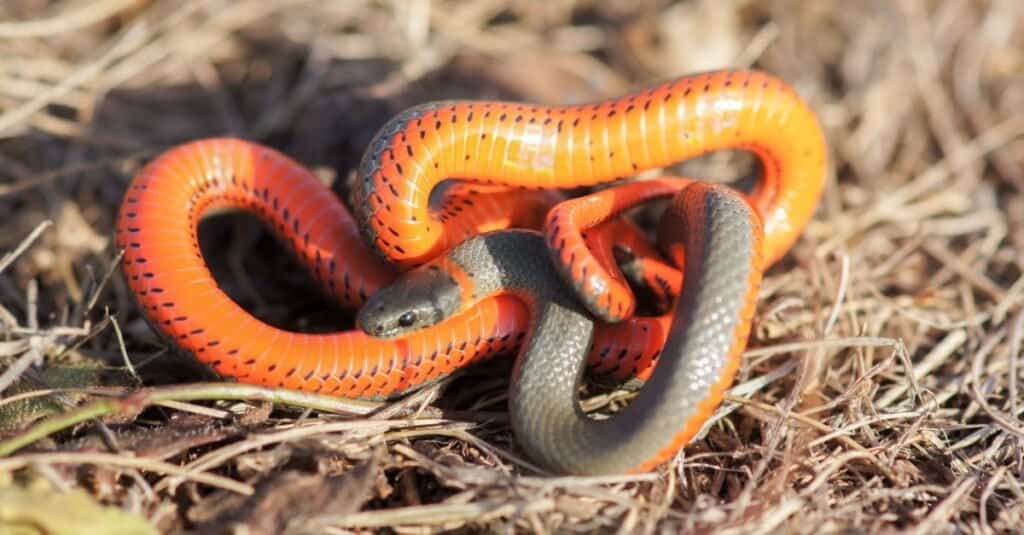
yhelfman/Shutterstock.com
As one of Washington State’s smaller black snakes, the ring-necked snake rarely grows longer than 22 inches. Their bodies are black or dark gray, with smooth shiny scales. There is also a vivid orange ring or band encircling the snake’s neck, and its belly is orange to red with tiny black spots. These snakes are listed as a species of conservation concern in Washington because their distribution is patchy, and they are rarely seen.
Ring-necked snakes usually live in the Columbia River Basin in Washington, particularly in mixed forest areas and shrubsteppes. However, they are extremely secretive snakes that rarely show themselves during the day. Ring-necked snakes are harmless to humans and eat small salamanders, earthworms, slugs, and occasionally small frogs, lizards, or juvenile snakes.
2. California Mountain Kingsnake (Lampropeltis zonata)
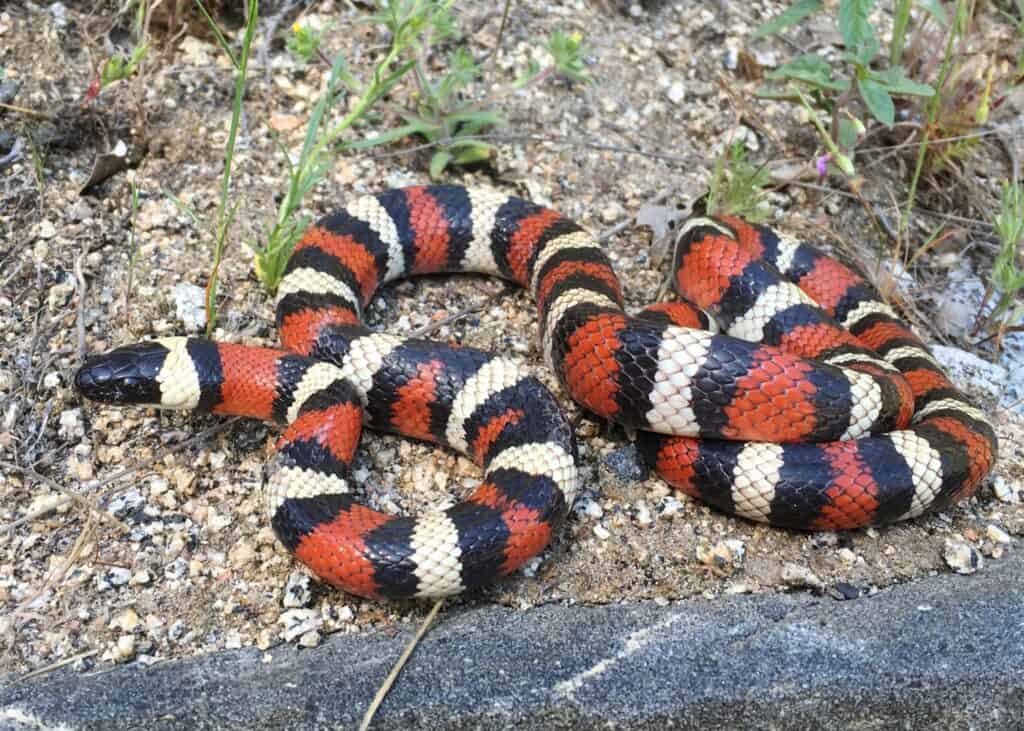
Matt Jeppson/Shutterstock.com
Although you might mistake a California mountain kingsnake for a venomous coral snake at first glance, have no fear: these snakes are completely harmless! California mountain kingsnakes only live in the northern regions of Washington State, in moist, forested regions. However, not a lot is known about these boldly colored snakes in Washington.
California mountain kingsnakes have white, red, and black bands along the length of their bodies, with the red bands bordered by black. Occasionally you might even see one that is just black and white, but this is not very common. No other snake species in Washington looks like a California mountain kingsnake.
3. Common Garter Snake (Thamnophis sirtalis)
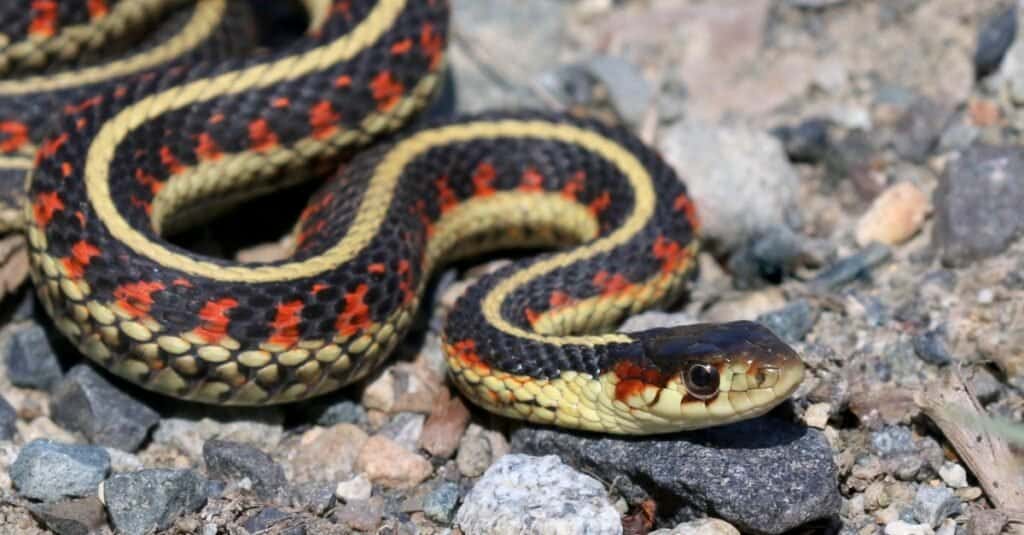
iStock.com/randimal
The most common snake in Washington State is the nonvenomous common garter snake. These snakes live all over the state, usually in areas near water. Common garter snakes are commonly seen in bogs, wetlands, springs, rivers, creeks, lakes, and ponds. They are excellent swimmers that can hunt both along the water’s surface as well as beneath it. Common garter snakes also enjoy sunny areas close to water, like oak patches, shrubs, meadows, and the edges of forests.
These snakes have keeled or ridged scales and long, slender bodies that are usually shorter than 54 inches long. Their bodies are dark gray or black, with a thin stripe running along the back and along each of the snake’s sides. These three stripes often vary in color, from bright yellow to blue, green, or turquoise. Some snakes, especially in eastern Washington, may have red blotches along their sides in addition to their stripes.
4. Western Terrestrial Garter Snake (Thamnophis elegans)
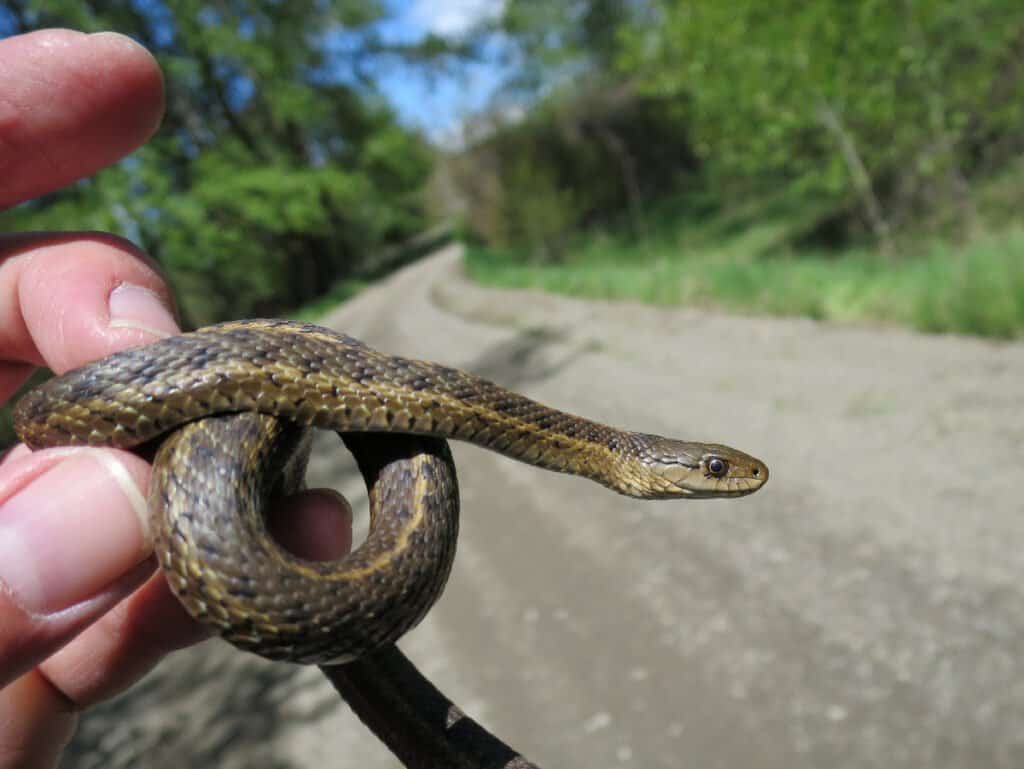
Randy Bjorklund/Shutterstock.com
The Western terrestrial garter snake is another nonvenomous black snake in Washington State, usually found near sources of water. Although these snakes live all throughout the state, they are not as common in the West Cascades, North Cascades, or along the northwestern coast. Western terrestrial garter snakes live along lakes, ponds, stream edges, wetlands, rivers, and irrigation canals, as well as shrubby and grassy areas nearby.
They are 38 inches long at the most and have dark bodies with three long stripes (one on the middle of the back, and one along each side of the body) and small dark spots. The stripes are cream-colored or yellow, with dark spots overlapping them. Although they are nonvenomous snakes, western terrestrial garter snakes do have some toxins in their saliva that helps with immobilizing their prey. Their bites are not fatal to humans, but they may cause some localized swelling.
5. Northwestern Garter Snake (Thamnophis ordinoides)
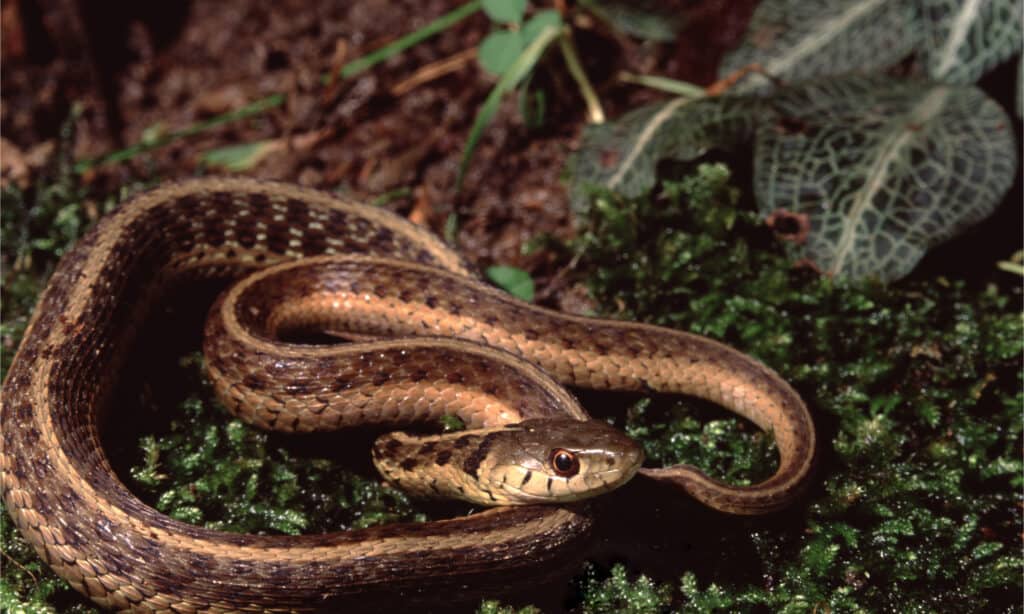
Liz Weber/Shutterstock.com
Although it has an appearance very similar to the other garter snakes in Washington State, the northwestern garter snake’s color and patterns vary tremendously. Some snakes are black while others are brown, often with the typical three stripes of other garter snakes. However, the stripes may be white, yellow, green, turquoise, red, orange, or blue. Some snakes do not have any stripes at all, and others have dark spots replacing areas of striping. The dorsal scales of many snakes also have additional white flecks along the edges.
Interestingly enough, the pattern of a northwestern garter snake appears to correspond to its chosen method of escape. For example, snakes with spots or without any patterns usually dart in one direction and then freeze as they attempt to camouflage with their environment. Snakes with stripes, on the other hand, usually slither away in a straight line. Northwestern garter snakes are the smallest of the three garter snake species in Washington State, growing no longer than 23.6 inches in length.
6. Western Racer (Coluber constrictor)
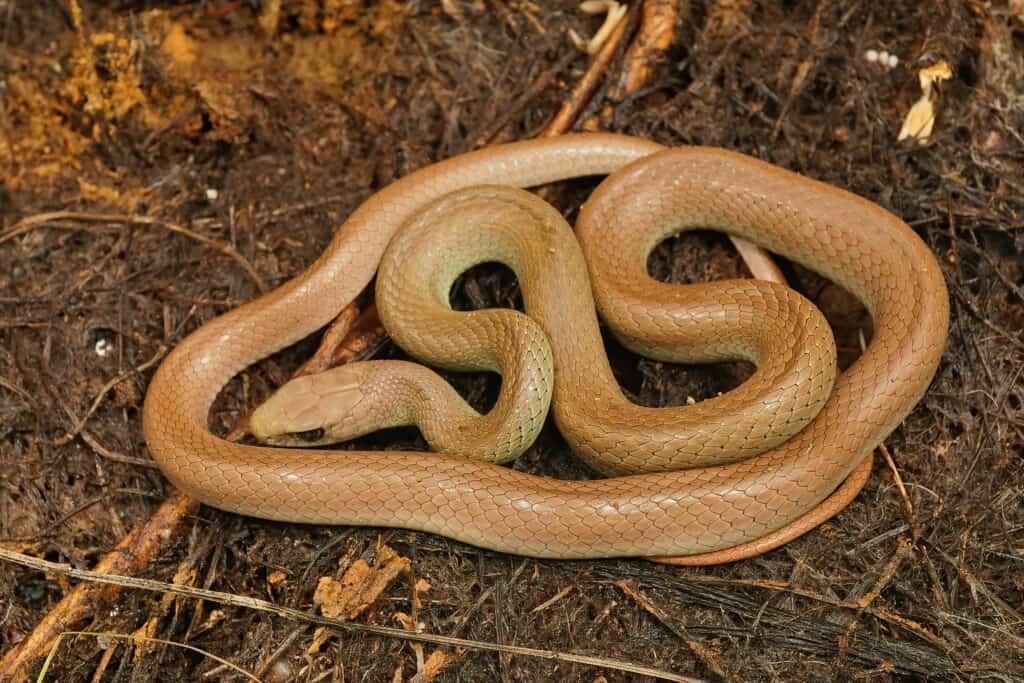
HWall/Shutterstock.com
Growing between three to six feet long, western racer snakes are primarily seen in eastern Washington and in the southern areas of Puget Sound. These snakes have dark bodies that are brownish, gray, dark green, or blackish in color, with pale yellow bellies. Like their name, racer snakes move extremely fast. Unlike Washington’s garter snakes, western racer snakes prefer dry and warm areas with brushy or open country.
When they hunt, racers often hold their heads and necks up high above the ground. Some are known to commonly climb trees as well, as they search for insects, reptiles, and small mammals to snack on. Baby and juvenile racer snakes are typically lighter in color with blotches down their backs. Some may even look like miniature gopher snakes until they get a bit older.
7. Desert Striped Whipsnake (Coluber taeniatus taeniatus)
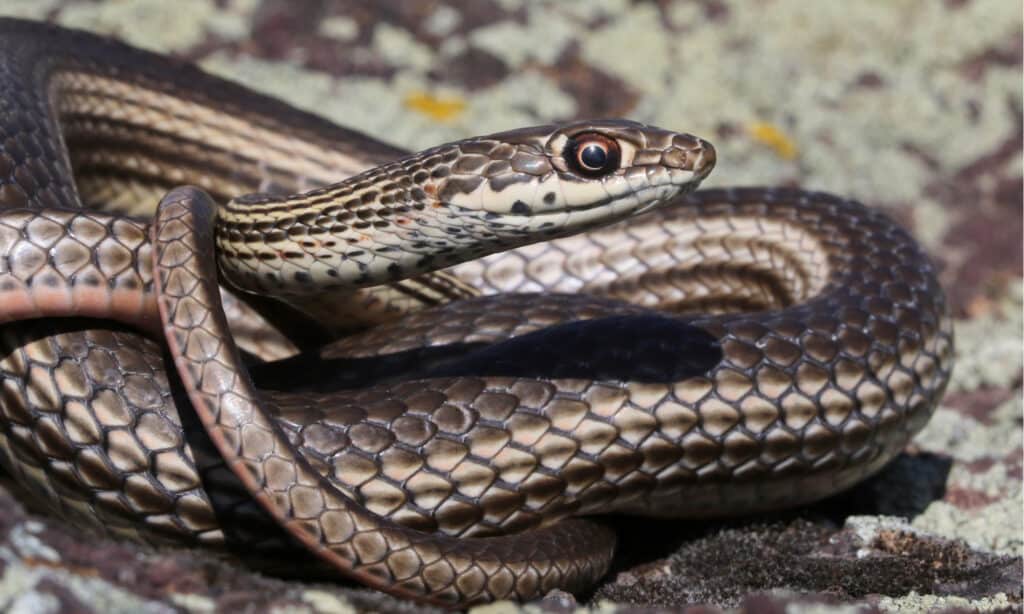
Randy Bjorklund/Shutterstock.com
The longest black snake in Washington State is the desert striped whipsnake, which can grow between 30-72 inches in length. However, it is also one of the state’s rarest snakes and currently is known to live in only two areas in Grant County in dry areas and shrubsteppes. These nonvenomous snakes have long, slender bodies that resemble a whip. Their bodies are dark with light-colored stripes running along each side and a white belly. They are fast snakes that hunt small mammals, ground-dwelling lizards, insects, snakes, and birds. Desert striped whipsnakes are also surprisingly long-living snakes and can live up to 20 years in the wild!
Up Next:
- Are Black Snakes Poisonous or Dangerous?
- Discover Washington State’s Only Rattlesnake Species
- Meet 7 Snakes of the Columbia River
- Discover The 7 Most Dangerous Animals In Washington, and Where You’ll Find Them
The post 7 Black Snakes in Washington State appeared first on AZ Animals.
from Animal News, Facts, Rankings, and More! - AZ Animals https://ift.tt/XnpWsf7